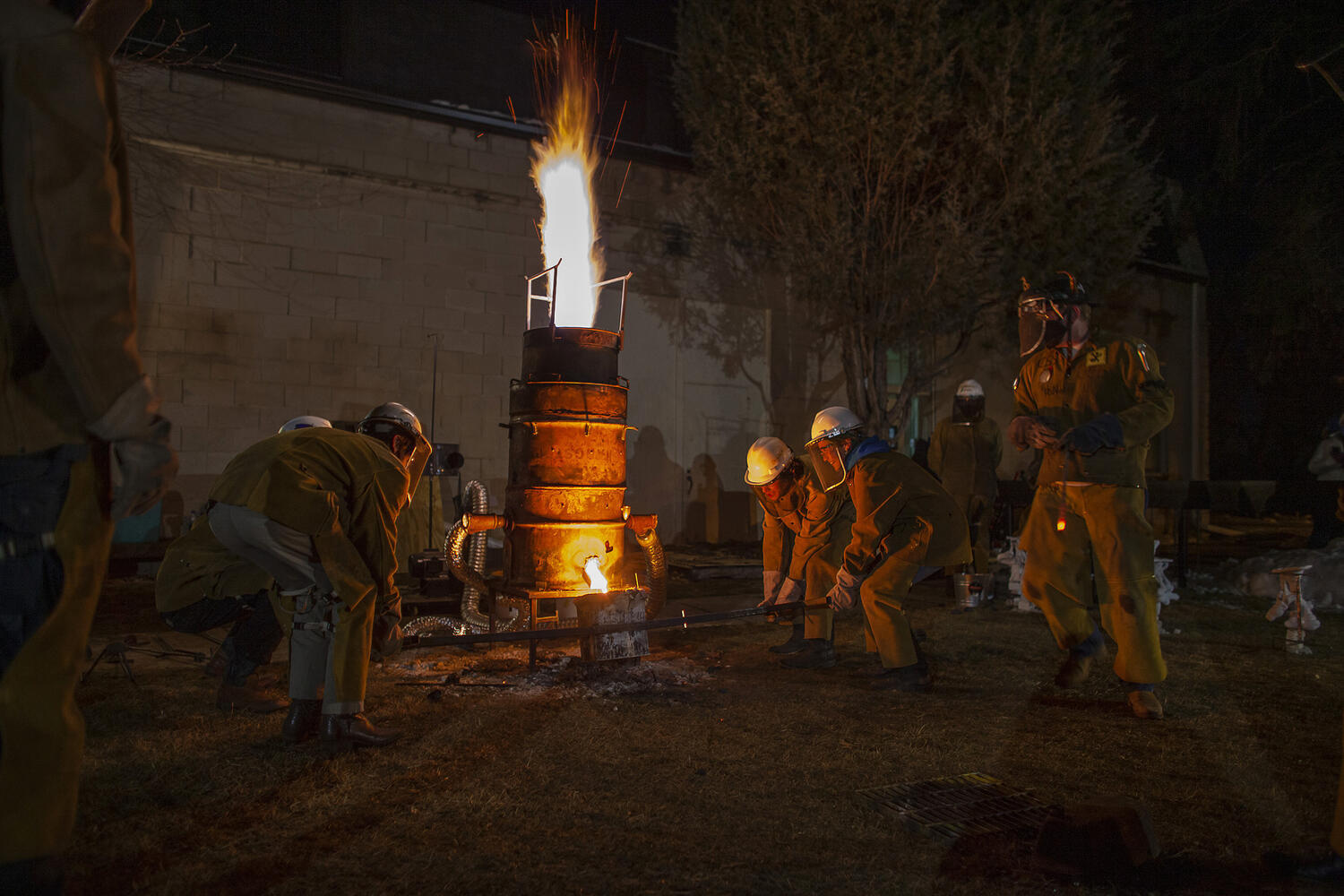
The Great Iron Pour (Dramatized):
The time had finally come, the day we’ve all been waiting for: the day of The Great Iron Pour. Thousands (closer to 20) people came to watch it. And as the night cooled down, ours was just beginning. As the temperature outside dropped, the temperature inside the furnace rose, along with our spirits and excitement. As more and more and more people joined the crowd, the crew donned their ceremonial leathers and got into positions. It was finally time. The Iron Wolfe approached, decorated with the spoils of previous pours. The first group stepped forward, setting the ladle down just below the tap, where molten iron would shortly be flowing. They crouched down level with the plug, protected only by a small piece of clay. The horned warrior broke the seal, releasing the glowing nectar of the cupola, forged by long-lost stars, millions of years ago, predestined to be turned into the sublime work of the talented crew. Once the chalice of molten nectar had filled to the brim, Hans the Horrible drove his fist into the molten hot iron, preventing it from flowing any further. Gingerly, the crew lifted their ladle, sending metal and sparks flying off into the crowd. Despite the uproar of the crowd, the Wrought Wolfe did not panic, guiding his prodigal crew to set their ladle down and await the purifier, with his tool in one hand, and a will of iron in the other. Overwatched by purifiers of past pours, he imperturbably cleansed the iron of its impurities, readying it to be poured. The ladle lifters were once more guided, for the final time, to pour. The crowd marveled, as they witnessed the glorious process of creation, the rebirth of the dormant iron, the genesis of the sublime product of the master metalworkers. Deep into the night, the crowd had retreated to their abodes, but Hans’ helpers stayed put, they had to finish what they had started. As the pour continued, life was added to the roaring dragon: the cupola. Fuel and iron were thrown in, and the fires were stoked. As soon as the last mold had been poured, the crew went silent, and the Iron Giant, the Great Wolfe, silenced the crowd. In one swift blow, he ended the short-lived reign of the dragon, letting its treasures, of slag, iron, and coke, fall to the ground, smoldering themselves out. The iron had been poured, the molds had been filled, and the crew had been thoroughly worn out. The pour was over. But Wolfe’s inner wolf had not been satisfied. He accepted to release his new prodigy but would be sure to return, sure to revive the dragon, and sure to keep the tradition of the Great Iron Pour. But until then, he will remain, head of the art department, cleaning up our mess over spring break.

The Great Iron Pour (Simplified):
On the day of the pour, we were ready; molds had been made, the cupola had been set, and everything was in place for a smooth pour. A few hours before the event, the cupola (the furnace used to melt the iron), was filled with coke (purified coal, our source of fuel) and heated. Once the coke got to around 2,000 degrees, we were ready to begin. The crew donned their protective leathers and helmets and began putting iron and smaller, more combustible pieces of coke into the furnace. About 10 minutes later, we were ready to pour. Four people took the ladle (a bucket with a lining that can withstand having molten metal in it) and placed it under the tap, where iron flows out of the cupola. The tap is sealed with a clay plug, called a bott, which was then removed, allowing the iron to flow. Once the ladle was somewhat full, a new bott was put into the tap, stopping the iron flow. The iron was then skimmed, to remove slag (glass and other impurities) from the surface of the iron. After this step, the iron was ready to pour. The four people holding the ladle moved it over a cup (a funnel for iron) leading to our lost wax artworks, and poured into it, until it was full. During this time, another group charged the cupola, that is, they put more coke and iron chunks into the furnace so that there would be molten iron ready for the next pour. To end the pour, the bottom of the cupola was dropped out, letting the remaining coke, iron, and slag (glass and impurities from the melting iron) fall out.




